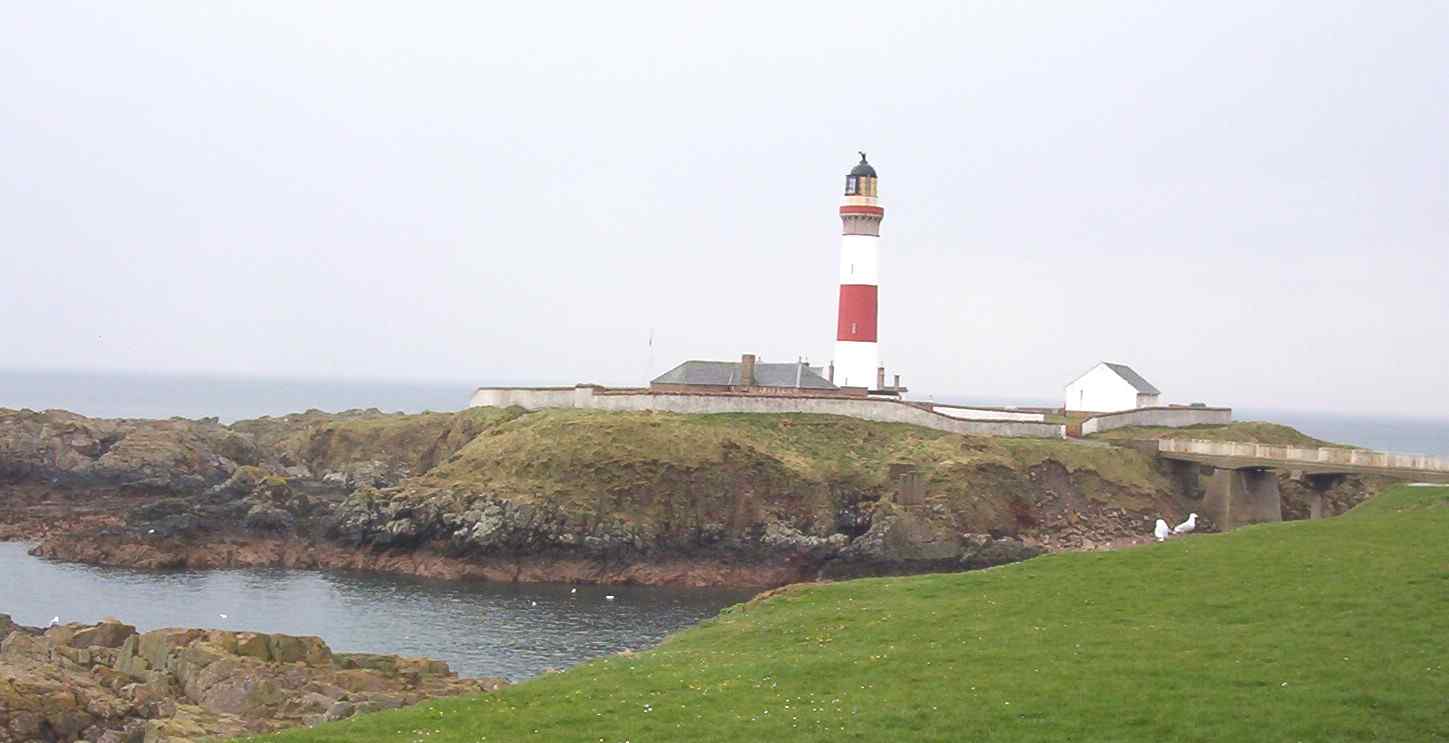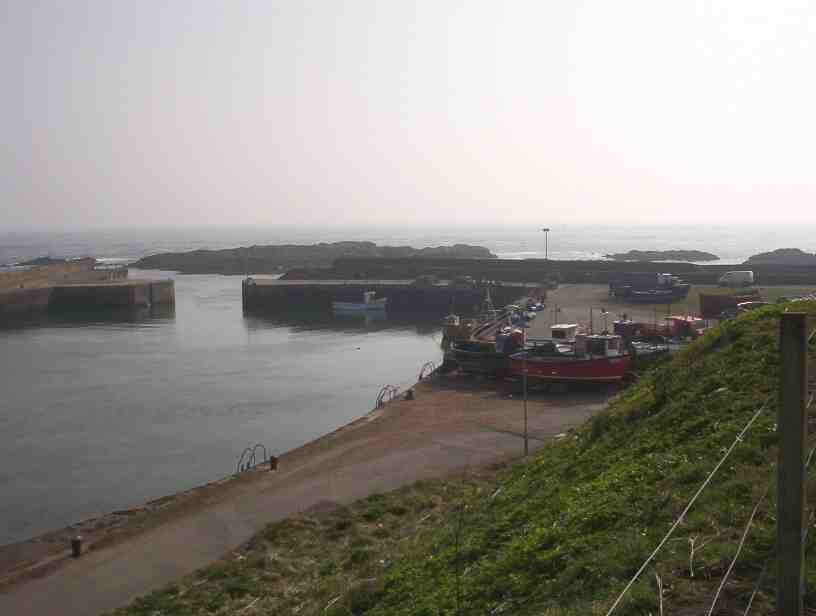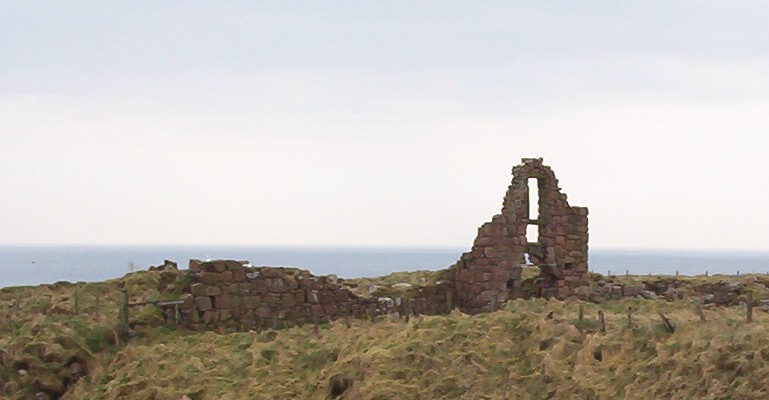
Boddam and District Community Association Webpages
Introduction - Boddam on the Internet
|
|
Boddam and District Community Association Webpages |
|
Introduction - Boddam on the Internet |
The village of Boddam (pop. 1500 approx.) sits on the extreme outer shoulder of Scotland. Its lighthouse on the Buchanness promontory is the most easterly part of Scotland. Stretching for miles southwards from Boddam, rugged, granite cliffs form a defence against the winter's mountainous seas and, not only provide a home for huge colonies of seabirds, but, vantage points to view some of nature's finest sculptures which have been carved by the sea over centuries.

Because the farmers have long left a broad safety margin between their agricultural efforts and the cliff's edge, we can still see many plants along these margins, such as wild orchids etc., which have been killed off elsewhere in the landward areas by the use of herbicides, pesticides etc. These cliffs, although always dangerous, allow a careful sea angler access to various fishing spots where cod, ling and other species can be caught if a wary eye is kept on the tide. Boddam has its own harbour and little fishing boats which work lobster pots and the "ripper line" form of fishing up and down the coast.

To the north of Boddam we have Scottish and Southern's Power Station which dominates the skyline and pours hot water into the sea at Sandford Bay. In the last year, sea bass has been caught for the first time ever and this may be due to either climatic change or the Power Station cooling water discharge.

Bait can be easily obtained locally by digging on local beaches or by visiting fish merchants. For the angler who wants to try out their sea rod fishing, places are not a problem and an easy access to the clifftops for the birdwatcher is on foot via a pathway.
Although other areas of Aberdeenshire have bigger castles, Boddam has what remains of one of Scotland's oldest castles and it is well worth a visit. Boddam Castle forms part of a group of three castles which belonged from medieval times to the Clan Keith. The other two, which are only some three miles distant from Boddam, are Ravenscraig and Inverugie. Although much diminished by the centuries, Boddam Castle still demonstrates to the historian or, anyone with a knowledge of medieval warfare, how much a part geography played in deciding where to erect a fortress. The castle is of the late 16th century and built by the Keith of Ludquharn. Three lightly fortified ranges form a courtyard 31 m by 28 m between sheer cliffs. The residential rooms may have been along the south with storage cellars on the north, closed off by a guardroom, gatehouse and small tower to the west. As Ian R.D. Bryce, FSAScot explained it in 2001 "Speculation: In the absence of certain knowledge it is perhaps permissible, certainly pleasurable, to idly speculate and to apply tried and tested patterns with which to flesh out the skeleton to a more immediately recognisable form. This may start with the south range where there are four chambers, each of a different size which argues four separate functions. Starting in the east, seaward, and working inland to the gate, we would suggest the Laird's Solar or Drawing Room, Hall, Kitchen and Tower.

The Hall is the largest room 12 m by 5 m internally (39ft by 16ft). It is interesting to note that the smallest hall house for which I have ascertained dimensions is Hestan Island, Kirkcudbright, which measures 11.2 m by 4.5 m (37ft by 16ft) so almost identical to Boddam's postulated hall. The Solar, 5 m square (16 ft. sq.) is at the rear of the court, the quiet away from the activity of arrival and departure. The Kitchen, 9 m by 7 m (29 ft by 23 ft) is set athwart the line of the range to project almost to the cliff edge and has a thickening of part of its west wall to 2 m (6 ft) which may have contained the kitchen fireplace. The 2.5 m (8 ft) square in the re-entering angle may be the base of a small tower, perhaps fitted with a bell to summon field labourers or reinforcements as the occasion demanded but hardly likely to be either residential or defensive. Along the west is an anonymous area which perhaps should be associated with the spur of wall projecting south beyond the Kitchen, an enclosure for raw or bulk foodstuffs such as oats. The gateway is conventional enough with the route constrained within flanking walls and perhaps an oubliette above for unwelcome guests. In the north-west corner we would then postulate a guardroom for the garrison. The three chambers down the north wall could be anything from storage to domestic accommodation, or both; the one below and the latter above in the garret. The elevations are less readily dealt with, even speculatively, but two factors combine to argue a fairly low profile. If the gatehouse rose to a room over the passage and attic in the roof it would presumably be the highest feature in the west facade, the show front, so the flanks would be a single storey with attic. The three ranges as just described would easily afford a lesser laird an adequate area about which to disperse his private and domestic household comfortably. Secondly, there is no evidence of a large tower a-la-Cordiner with multiple storeys. In fact the whole layout is more reminiscent of a 19th century farm steading than a 16th century extensive and imposing mansion although the location between sheer cliffs will have heightened the effect to those no higher than on horseback."
A display board has been placed on the entrance path to the castle which, with professional advice, sets out the history of Boddam Castle along with an artist's impression of what it may have looked like in its days of glory. Other works are planned on the castle site, such as an improved pathway access and another display board setting out the floor plan of the castle.
Perhaps the most notable and among the last inhabitants of Boddam Castle was Sir William Keith, who was born there in 1669. He was their heir apparent to the baronetcy of his father, William. His mother was Jean Smith, a relative by marriage, to the Graham Clan. In 1680 he was baptised into the Church of England. While the rest of the Keith family in the north-east of Scotland were taking part in the Jacobite rebellion of 1715, this Sir William Keith of Ludquharn had already been appointed Surveyor General for the Southern District of the Americas since 1713 and was making a name for himself there, becoming Lieutenant Governor of Pennsylvania. His fortunes went on the slide however and Sir William Keith eventually found himself back in Britain where he was plagued by old debts and lived the life of a discarded public official. He died in 1749 in the Old Baily, a liberty or parole section of the Fleet Street Prison.
Introduction
| Brochure | Councillors |Community
Association
Senior Citizens' Association | Amenities | Stirlinghill
Quarries | Map
of Area | Links
Enquiries : enquiries@boddam.org.uk